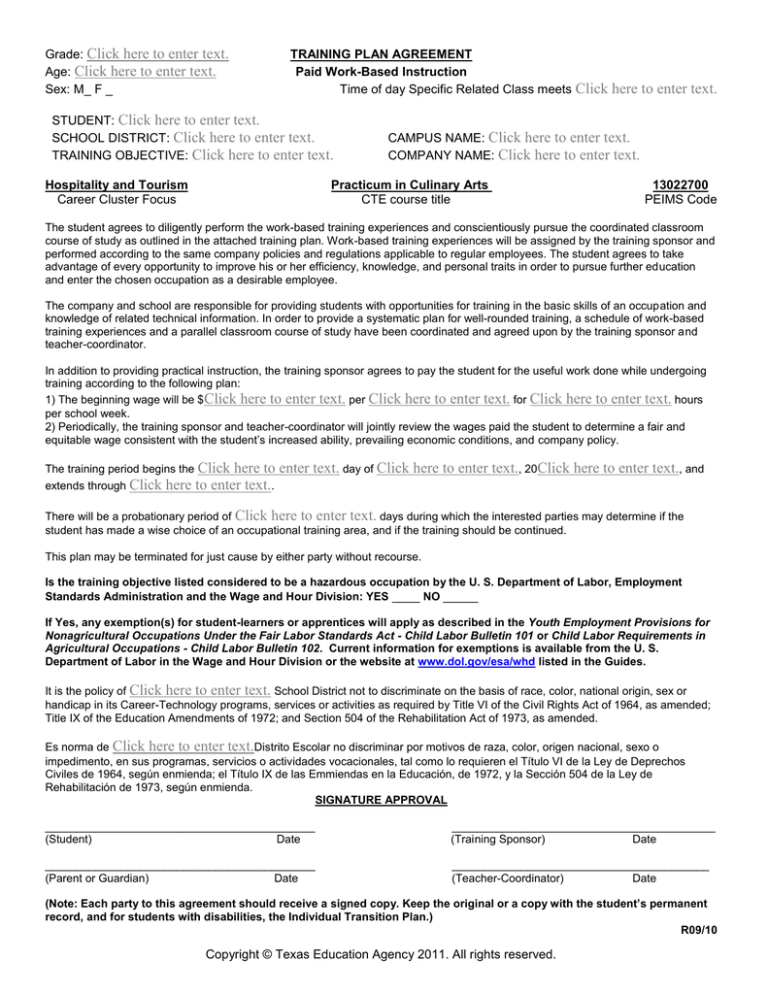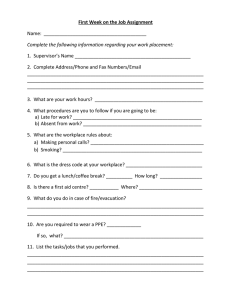
Grade: Click here to enter text.
Age: Click here to enter text.
Sex: M_ F _
TRAINING PLAN AGREEMENT
Paid Work-Based Instruction
Time of day Specific Related Class meets
STUDENT: Click here to enter text.
SCHOOL DISTRICT: Click here to enter text.
TRAINING OBJECTIVE: Click here to enter text.
Hospitality and Tourism
Career Cluster Focus
Click here to enter text.
CAMPUS NAME: Click here to enter text.
COMPANY NAME: Click here to enter text.
Practicum in Culinary Arts
CTE course title
13022700
PEIMS Code
The student agrees to diligently perform the work-based training experiences and conscientiously pursue the coordinated classroom
course of study as outlined in the attached training plan. Work-based training experiences will be assigned by the training sponsor and
performed according to the same company policies and regulations applicable to regular employees. The student agrees to take
advantage of every opportunity to improve his or her efficiency, knowledge, and personal traits in order to pursue further education
and enter the chosen occupation as a desirable employee.
The company and school are responsible for providing students with opportunities for training in the basic skills of an occupation and
knowledge of related technical information. In order to provide a systematic plan for well-rounded training, a schedule of work-based
training experiences and a parallel classroom course of study have been coordinated and agreed upon by the training sponsor and
teacher-coordinator.
In addition to providing practical instruction, the training sponsor agrees to pay the student for the useful work done while undergoing
training according to the following plan:
1) The beginning wage will be $Click here to enter text. per Click here to enter text. for Click here to enter text. hours
per school week.
2) Periodically, the training sponsor and teacher-coordinator will jointly review the wages paid the student to determine a fair and
equitable wage consistent with the student’s increased ability, prevailing economic conditions, and company policy.
The training period begins the Click
extends through Click
here to enter text. day of Click here to enter text., 20Click here to enter text., and
here to enter text..
There will be a probationary period of Click here to enter text. days during which the interested parties may determine if the
student has made a wise choice of an occupational training area, and if the training should be continued.
This plan may be terminated for just cause by either party without recourse.
Is the training objective listed considered to be a hazardous occupation by the U. S. Department of Labor, Employment
Standards Administration and the Wage and Hour Division: YES ____ NO _____
If Yes, any exemption(s) for student-learners or apprentices will apply as described in the Youth Employment Provisions for
Nonagricultural Occupations Under the Fair Labor Standards Act - Child Labor Bulletin 101 or Child Labor Requirements in
Agricultural Occupations - Child Labor Bulletin 102. Current information for exemptions is available from the U. S.
Department of Labor in the Wage and Hour Division or the website at www.dol.gov/esa/whd listed in the Guides.
It is the policy of Click here to enter text. School District not to discriminate on the basis of race, color, national origin, sex or
handicap in its Career-Technology programs, services or activities as required by Title VI of the Civil Rights Act of 1964, as amended;
Title IX of the Education Amendments of 1972; and Section 504 of the Rehabilitation Act of 1973, as amended.
Es norma de Click here to enter text.Distrito Escolar no discriminar por motivos de raza, color, origen nacional, sexo o
impedimento, en sus programas, servicios o actividades vocacionales, tal como lo requieren el Título VI de la Ley de Deprechos
Civiles de 1964, según enmienda; el Título IX de las Emmiendas en la Educación, de 1972, y la Sección 504 de la Ley de
Rehabilitación de 1973, según enmienda.
SIGNATURE APPROVAL
___________________________________________
(Student)
Date
__________________________________________
(Training Sponsor)
Date
___________________________________________
(Parent or Guardian)
Date
_________________________________________
(Teacher-Coordinator)
Date
(Note: Each party to this agreement should receive a signed copy. Keep the original or a copy with the student’s permanent
record, and for students with disabilities, the Individual Transition Plan.)
R09/10
Copyright © Texas Education Agency 2011. All rights reserved.
Description of Specific and Related Occupational Training
The occupational essential knowledge and skills listed below are provided as a convenience to promote quality standards in work-based training.
Additional space is available to add specific training opportunities not otherwise identified as essential knowledge and skills. NOTE: Occupational
training objectives having no state adopted essential knowledge and skills will require the training plans to be individually developed.
Essential Knowledge and Skills
for Training Objective
WorkBased
Instruction
Individualized
Class Study
(1) The student uses employability skills to gain an entry-level job in a high-skill,
high-wage, or high-demand field. The student is expected to:
(A) identify employment opportunities
(B) demonstrate the application of essential workplace skills in the career
acquisition process
(C) complete employment-related documents such as job applications and I-9
and W-4 forms
(D) demonstrate proper interview techniques in various situations
(2) The student develops skills for success in the workplace. The student is
expected to:
(A) comprehend and model appropriate grooming and appearance for the
workplace
(B) demonstrate dependability, punctuality, and initiative
(C) develop positive interpersonal skills, including respect for diversity
(D) demonstrate appropriate business and personal etiquette in the workplace
(E) exhibit productive work habits, ethical practices, and a positive attitude
(F) demonstrate knowledge of personal and occupational health and safety
practices in the workplace
(G) demonstrate the ability to work with the other employees to support the
organization and complete assigned tasks
(H) prioritize work to fulfill responsibilities and meet deadlines
(I) evaluate the relationship of good physical and mental health to job success
and personal achievement
(J) demonstrate effective verbal, non-verbal, written, and electronic
communication skills
(K) apply effective listening skills used in the workplace
(3) The student demonstrates work ethics, employer expectations, interaction with
diverse populations, and communication skills in the workplace. The student is
expected to:
(A) illustrate how personal integrity affects human relations on the job
(B) demonstrate characteristics of successful working relationships such as
teamwork, conflict resolution, self-control, and the ability to accept criticism
(C) analyze employer expectations
(D) demonstrate respect for the rights of others
(E) demonstrate ethical standards
(F) comply with organizational policies
(4) The student applies academics with job-readiness skills. The student is
expected to:
(A) apply mathematical skills to business transactions
(B) develop a personal budget based on career choice
(C) interpret data from documents such as tables, charts, and graphs to
estimate and find solutions to problems
(D) organize and compose workplace documents
(5) The student applies ethical behavior standards and legal responsibilities within
the workplace. The student is expected to:
(A) research and compare published workplace policies
(B) apply responsible and ethical behavior
(C) summarize provisions of the Fair Labor Standards Act
(D) describe the consequences of breach of confidentiality laws related to
culinary arts professions
(6) The student applies the use of self-development techniques and interpersonal
skills to accomplish objectives. The student is expected to:
(A) identify and practice effective interpersonal and team-building skills involving
situations with coworkers, managers, and customers
(B) apply leadership and career development skills through participation in
activities such as career and technical student organizations
Copyright © Texas Education Agency 2011. All rights reserved.
Specific Related
Study
Assignments
Essential Knowledge and Skills
for Training Objective
WorkBased
Instruction
Individualized
Class Study
(7) The student uses concepts and skills related to safety in the workplace. The
student is expected to:
(A) identify and apply safe working practices
(B) solve problems related to unsafe work practices and attitudes
(C) explain Occupational Safety and Health Administration regulations in the
workplace
(D) analyze health and wellness practices that influence job performance
(8) The student evaluates personal attitudes and work habits that support career
retention and advancement. The student is expected to:
(A) analyze the future employment outlook in the occupational area
(B) describe entrepreneurial opportunities in the area of culinary arts
(C) compare rewards and demands for various levels of employment in the
area of culinary arts
(D) evaluate strategies for career retention and advancement in response to the
changing global workplace
(E) summarize the rights and responsibilities of employers and employees
(F) determine effective money management and financial planning techniques
(9) The student identifies skills and attributes necessary for professional
advancement. The student is expected to:
(A) evaluate employment options, including salaries and benefits
(B) determine factors that affect career choices such as personal interests,
abilities, priorities, and family responsibilities
(C) determine continuing education opportunities that enhance career
advancement and promote lifelong learning
(D) demonstrate effective methods to secure, maintain, and terminate
employment
(10) The student understands the history of food service and the use of the
professional kitchen. The student is expected to:
(A) research famous chefs in history and note their major accomplishments
(B) identify global cultures and traditions related to food
(C) summarize historical entrepreneurs who influenced food service in the
United States
(D) analyze how current trends in society affect the food service industry
(E) use large and small equipment in a commercial kitchen
(F) develop food production and presentation techniques
(G) demonstrate moist and dry cookery methods
(H) demonstrate food preparation skills used in commercial food service
preparations such as breakfast cookery, salads and dressings, soups and
sandwiches, stocks and sauces, appetizers, seafood, poultry cookery, meat
cookery, pastas and grains, and fruits and vegetables
(I) demonstrate baking techniques such as yeast breads and rolls, quick breads,
and desserts
(J) demonstrate proper receiving and storage techniques
(K) demonstrate proper cleaning of equipment and maintenance of the
commercial kitchen
(L) demonstrate types of table setting, dining, and service skills
(11) The student documents technical knowledge and skills. The student is
expected to:
(A) complete a professional career portfolio to include:
(i) an updated resumé;
(ii) official documentation of attainment of technical skill competencies;
(iii) licensures or certifications;
(iv) recognitions, awards, and scholarships;
(v) community service hours;
(vi) participation in student and professional organizations;
(vii) abstract of key points of the practicum; and
(viii) practicum supervisor evaluations
(B) present the professional career portfolio to interested stakeholders
Copyright © Texas Education Agency 2011. All rights reserved.
Specific Related
Study
Assignments
Advanced Occupationally Specific
Knowledge and Skills
Work-Based
Instruction
Individualized
Class Study
Specific Related
Study
Assignments
NOTE: The above should serve as a suggested format. Space allowances should be expanded to accommodate inclusion of appropriate information.
R09/10
Copyright © Texas Education Agency 2011. All rights reserved.




